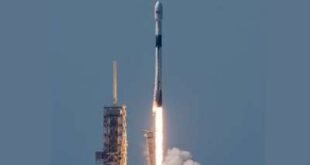
In a remarkable feat that underscores India’s prowess in space exploration, Chandrayaan 3 has reached another historic milestone as the Pragyan rover captures the very first image of the Vikram lander on the moon’s surface, just a week after the successful soft landing of the lunar mission. This significant accomplishment serves as a testament to India’s advancement in space science.
The image, taken by the navigation camera aboard the Pragyan rover, was unveiled on Wednesday morning at 7:35 am (Indian Standard Time), marking an extraordinary moment in India’s lunar exploration journey. In this captivating image, the Vikram lander stands resolute on the lunar terrain, and two of its payloads, namely ChaSTE and ILSA, are prominently visible, as pointed out by the Indian Space Research Organisation (ISRO).
This revelation follows the sharing of Pragyan’s videos and photos by Vikram in the preceding week. A notable highlight was the image of Vikram lander seen from the Chandrayaan 2 orbiter, although this was subsequently removed. However, this latest photograph holds special significance as it portrays the Vikram lander in its entirety on the moon’s south pole, offering an unprecedented view of its resting place, aptly referred to as the Shiv Shakti Point.
Vikram, the lander of Chandrayaan 3, executed a soft landing on the moon’s south pole while carrying the Pragyan rover. Following a period of lunar dust settling, Pragyan commenced its operational activities. The rover’s first task involved rolling out from the lander and embarking on a traverse across the lunar surface. Over the past week, Chandrayaan 3 unveiled a series of groundbreaking findings about the moon, a significant accomplishment as no previous spacecraft had touched down on the moon’s south pole.
The Vikram lander boasts four essential payloads: RAMBHA, designed to measure near-surface plasma density; ChaSTE, which examines thermal soil properties; ILSA, dedicated to seismicity measurement around the landing site; and LRA, focusing on lunar system dynamics.
Since its historic landing, the Vikram lander has been actively involved in scientific pursuits. The ChaSTE payload, for instance, provided insights into the moon’s thermal dynamics, highlighting a substantial temperature variation from -10 degrees Celsius to 60-70 degrees Celsius, ranging from depths of -80 mm beneath the surface to 20 mm above the ground.
Simultaneously, the Pragyan rover undertook a series of vital tasks following its rollout from the Vikram lander. These included dynamic path adjustments based on its observations, study of elemental compositions in the moon’s south pole, and the confirmation of the presence of sulfur, oxygen, aluminum, calcium, and more.
The unveiling of Vikram lander’s image by Pragyan stands as a remarkable moment in India’s space exploration journey, fostering new revelations and expanding our understanding of the moon’s unique characteristics. As India continues its mission to unravel the mysteries of the cosmos, the accomplishments of Chandrayaan 3 serve as a testament to human ingenuity and determination.
Sources By Agencies
 Digital Scoop India Official Platform of Digital Scoop India Featuring Latest & Best News #Articles #Bytes #Entertainment #DigitalScoopMagazine
Digital Scoop India Official Platform of Digital Scoop India Featuring Latest & Best News #Articles #Bytes #Entertainment #DigitalScoopMagazine


